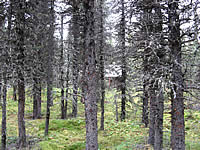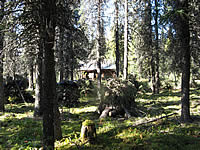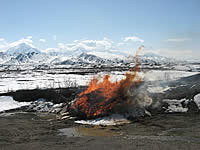Forests and Rangelands Success Story
Hazard Fuels Plan and Omnibus Burn Plans Contribute to More Fuels Management Accomplishments
Denali National Park and Preserve, Alaska
National Fire Plan - Fuels Reduction
2008

Backcountry cabin in 2008 before a fuels reduction project at Denali National Park and Preserve.

Backcountry cabin after the fuels reduction project.

Pile burning near the Alaska Range, Denali National Park and Preserve.
In previous years, the Alaska Western Area Fire Management Program (AWAFMP) staff accomplished hazardous fuel reduction projects, but preparation and planning was not only repetitive and time consuming but also limited the staff’s ability to complete numerous projects in a single season. Given these challenges last season, AWAFMP strived to make the practice of hazard fuel reduction more efficient by writing three overarching plans. First, staff added the Hazard Fuels Treatment Plan to the Denali National Park and Preserve (NP&P) Fire Management Plan in July 2007. This treatment plan provides guidance for all fuels treatment projects in Denali NP&P. It cuts down on office preparation time and makes fieldwork uniform and easier to decipher.
In addition, the AWAFMP staff completed the Omnibus Road Side and Backcountry Burn Plans. These plans allow for burning large debris piles at designated sites along the Denali Park Road and hand piles from fuels treatment projects around backcountry structures. The plans include multiple prescribed fire areas with similar site characteristics (fuels types, weather, topography, etc) and outlines burn parameters for each site type. They also create guidelines for each burn. The creation of these three products eliminated redundancy in the hazard fuels treatment planning process.
With the Hazard Fuels Treatment Plan and the Omnibus Burn Plans in place, the 2008 AWAFMP staff accomplished more hazard fuels treatment projects and prescribed burns this season than ever before. The staff spending less time in the office and more time in the field enabled them to treat 11 sites totaling 10,468 acres at Denali, almost doubling previous year’s totals. This increase in the amount of park infrastructure and culturally significant sites treated gave AWAFMP supervisors and seasonal employees more hands-on opportunities, field experience, and increased each individual’s overall value to the AWAFMP and to the interagency wildland fire community.
Contact: Charlie Reynar, Acting Assistant Fire Management Officer, (907) 683-9549.